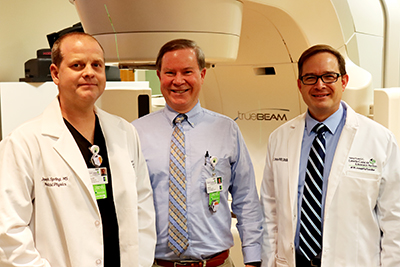Is radiation therapy safe?
Cancer
LCRP medical physicist explains the steps we take to ensure safe delivery of treatment
Radiation therapy has been used to help treat cancer for more than 100 years. Advancements in technology and radiation physics have made it an even safer and more efficient treatment option. However, there’s still many misconceptions out there about radiation therapy, one being its safety.
Radiation therapy is the use of X-rays to treat cancer. The radiation kills cancer cells or slows their growth so they stop dividing or die. When the damaged cells die, they are broken down and removed by the body.
Related Article: What is radiation therapy?

There are several types of radiation therapy that a patient can receive, but the two most common are external beam radiation therapy (EBRT) and brachytherapy, explains Joey Spring, medical physicist at the Nancy N. and J.C. Lewis Cancer & Research Pavilion. Spring is one of three physicists in the radiation therapy department in whom the responsibility lies for the safe and accurate delivery of radiation. (Pictured R-L: Joey Spring, Steven White and Caleb Price)
With EBRT, radiation is delivered by a linear accelerator that aims at a certain part of the body. At the LCRP, we have two types of linear accelerators, TrueBeam and CyberKnife®. Both machines deliver precise radiation beams to the cancer cells while minimizing damage to surrounding tissue and organs.
Brachytherapy is when a patient can have one or more permanent or temporary radioactive sources placed into their body. With a permanent implant, the radiation will decay over a certain period of time and no longer produce radiation, Spring says. With a temporary implant, the patient is only radioactive during the actual procedure and will not produce radiation once the source is removed, he describes.
Both radiation treatment options are safe, and many steps are taken to ensure our patients’ wellbeing.
“Radiation therapy is extremely safe. During treatment, radiation is delivered in a quality controlled, safe environment,” Spring says. “While radiation therapy has been around for more than a century, it has improved dramatically in recent years as a result of advances in technology and radiation physics.”
Steps we take to ensure patient safety
It’s a total team effort at the LCRP’s radiation oncology locations (Savannah, Bluffton and Hilton Head). We have highly-skilled radiation oncologists, medical physicists, dosimetrists, radiation therapists, nurses and others who work together in order to care for our patients at the highest level of quality and safety.
The team works together to develop a specific, individualized radiation treatment plan for patients prior to the start of treatment.
Related Article: What is radiation treatment planning?
Then throughout the treatment, the entire radiation therapy team performs safety checks at every stage of the treatment course, Spring says. Our physicists use highly-advanced software to help monitor each patient’s treatment session to ensure the treatment plan is being accurately followed.
Related Article: How people and technology work together to deliver high-quality radiation therapy
For those receiving EBRT, of which the majority of patients do, the LCRP has the most advanced linear accelerators in the TrueBeam and CyberKnife® machines.
“Our linear accelerators come with sophisticated imaging and tracking technology that allows us to accurately target and track many different types of cancers with submillimeter accuracy, even with tumors that move,” Spring says.
For example, when treating lung cancer, your lungs are going to move with normal breathing. Because of the advanced technology at the LCRP, we are able to treat the tumor while sparing healthy tissue, which allows us to deliver higher doses in fewer treatments, Spring says.
Additionally, our linear accelerators have checks and balances built-in to ensure that the amount of radiation that is prescribed is accurately delivered, Spring says. The machines also undergo daily, weekly, monthly and annual testing to validate all the information that is used to plan and treat patients. As an additional check, some of the data that is collected during the annual review of each machine is independently verified, Spring says.
“Many steps are taken to ensure the safety of our patients.”
ACR accreditation
The Lewis Cancer & Research Pavilion’s radiation oncology practice is the only American College of Radiology (ACR) accredited facility in the region. ACR accreditation involves a voluntary, rigorous review process that aims to make sure our oncology center meets national accepted standards, Spring explains.
“Having an ACR accreditation provides assurance to our patients that our team is committed to providing the safest and best quality of care possible.”